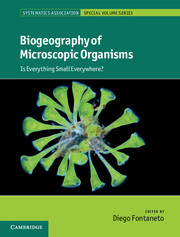Book contents
- Frontmatter
- Contents
- List of contributors
- Preface
- Part I Theoretical framework
- Part II Prokaryotes
- Part III Unicellular eukaryotes
- 5 Dispersal of protists: the role of cysts and human introductions
- 6 Everything is everywhere: a twenty-first century de-/reconstruction with respect to protists
- 7 Arcellinida testate amoebae (Amoebozoa: Arcellinida): model of organisms for assessing microbial biogeography
- 8 Everything is not everywhere: the distribution of cactophilic yeast
- Part IV Pluricellular eukaryotes
- Part V Processes
- Index
- Systematics Association Publications
- Systematics Association Special Volumes
- Plate section
- References
8 - Everything is not everywhere: the distribution of cactophilic yeast
from Part III - Unicellular eukaryotes
Published online by Cambridge University Press: 05 August 2012
- Frontmatter
- Contents
- List of contributors
- Preface
- Part I Theoretical framework
- Part II Prokaryotes
- Part III Unicellular eukaryotes
- 5 Dispersal of protists: the role of cysts and human introductions
- 6 Everything is everywhere: a twenty-first century de-/reconstruction with respect to protists
- 7 Arcellinida testate amoebae (Amoebozoa: Arcellinida): model of organisms for assessing microbial biogeography
- 8 Everything is not everywhere: the distribution of cactophilic yeast
- Part IV Pluricellular eukaryotes
- Part V Processes
- Index
- Systematics Association Publications
- Systematics Association Special Volumes
- Plate section
- References
Summary
Introduction
Cactophilic yeast form a community of fungi confined to the necrotic tissues of certain species of cacti. Although there is much we do not know about this community, our current understanding has implications for the generality of the ‘Everything is everywhere, but the environment selects’ (EiE) hypothesis (Finlay and Clarke, 1999; Fenchel and Finlay, 2004a; de Wit and Bouvier, 2006). The hypothesis of ubiquitous distributions for free-living microbial species is attractive because it solves a conceptual problem for biologists studying such small organisms: how do they discover new resource patches when their motion is passive? EiE provides an answer. Microbes reach such large population sizes that passive dispersal is sufficient to discover a new resource as it becomes available. It is a positive feedback loop. The larger its global population, the more likely a microbe is to find new resources and the larger its global population will become, increasing its likelihood of discovering more resources. Microbes that live in a patchy environment can quickly overexploit the patches and must often undergo difficult migrations across inhospitable territory in order to reach the next patch. This is true if distance, time or both separate patches. As passive agents, they must be resistant to the stresses inherent in dispersal. For microbes in a patchy habitat, ubiquity is not only an outcome of large population sizes. It also rests on the assumption of passive dispersal of resistant life forms, often in the form of resistant spores.
- Type
- Chapter
- Information
- Biogeography of Microscopic OrganismsIs Everything Small Everywhere?, pp. 130 - 174Publisher: Cambridge University PressPrint publication year: 2011
References
- 14
- Cited by



